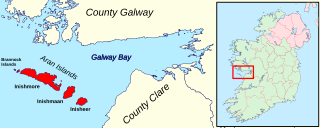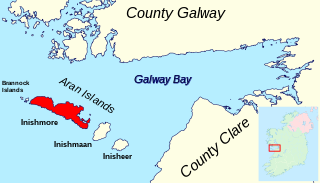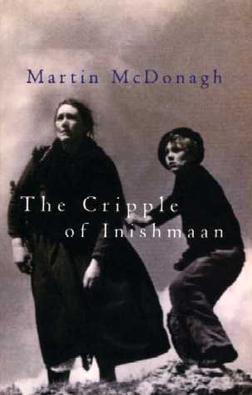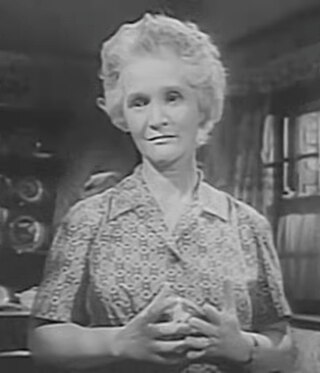
Robert Joseph Flaherty, was an American filmmaker who directed and produced the first commercially successful feature-length documentary film, Nanook of the North (1922). The film made his reputation and nothing in his later life fully equaled its success, although he continued the development of this new genre of narrative documentary with Moana (1926), set in the South Seas, and Man of Aran (1934), filmed in Ireland's Aran Islands. Flaherty is considered the father of both the documentary and the ethnographic film.

Galway Bay is a bay on the west coast of Ireland, between County Galway in the province of Connacht to the north and the Burren in County Clare in the province of Munster to the south; Galway city is on the northeast side. The bay is about 50 kilometres (30 mi) long and from 10 kilometres (6 mi) to 30 kilometres (20 mi) in breadth. The Aran Islands are to the west across the entrance and there are numerous small islands within the bay. To the west of Galway, the rocks are granite but to the south they are limestone.

The Aran Islands or The Arans are a group of three islands at the mouth of Galway Bay, off the west coast of Ireland, with a total area around 46 km2 (18 sq mi). They constitute the historic barony of Aran in County Galway.

Man of Aran is a 1934 Irish fictional documentary (ethnofiction) film shot, written and directed by Robert J. Flaherty about life on the Aran Islands off the western coast of Ireland. It portrays characters living in premodern conditions, documenting their daily routines such as fishing off high cliffs, farming potatoes where there is little soil, and hunting for huge basking sharks to get liver oil for lamps. Some situations are fabricated, such as one scene in which the shark fishermen are almost lost at sea in a sudden gale. Additionally, the family members shown are not actually related, having been chosen from among the islanders for their photogenic qualities.

Martin Faranan McDonagh is a British-Irish playwright, screenwriter, director, and producer. He is known for his absurdist black humour which often challenges the modern theatre aesthetic. He has received numerous accolades including an Academy Award, six BAFTA Awards, four Golden Globe Awards, three Olivier Awards, and nominations for five Tony Awards.
This is a bibliography of works relating to the Aran Islands.
Saint Enda of Aran is an Irish saint. His feast day is 21 March.

Inishmore is the largest of the Aran Islands in Galway Bay, off the west coast of Ireland. With an area of 31 km2 (12 sq mi) and a population of 820, it is the second-largest island off the Irish coast and most populous of the Aran Islands.

The Cripple of Inishmaan is a dark comedy by Martin McDonagh who links the story to the real life filming of the documentary Man of Aran.
Patrick Joseph Nee is an Irish-American former mobster and Irish republican sympathizer. A former member of the Mullen Gang and the Winter Hill Gang, he is a Vietnam War veteran, and author of A Criminal and an Irishman; The Inside Story of the Boston Mob-IRA Connection.

Barbara Mullen was an American-born actress well known in the United Kingdom for playing the part of Janet McPherson, the housekeeper in Dr. Finlay's Casebook. Although the role of Janet brought her fame in later years, she already had made her mark in the theatre.

Inishmore Aerodrome is located 1 nautical mile southeast of Kilronan, a town on the island of Inishmore, one of the Aran Islands off the coast of County Galway in Ireland. It has one paved runway designated 14/32 which measures 490 by 18 m.
Bridget Dirrane was an Irish nurse, centenarian and memoirist.
Gregory Ceannanach, early Irish missionary, fl. c. 490-500?

Aer Arann Islands is an Irish airline headquartered in Inverin, County Galway. They operate a three-strong fleet of Britten-Norman BN-2 Islander aircraft to connect the Aran Islands with mainland County Galway.

Oidhche Sheanchais is a 1935 Irish film directed by Robert J. Flaherty, who was also the cinematographer for the film. It was produced during the sound recording session for his more famous docufiction film Man of Aran in London, and is notable as the first Irish language sync sound film.

Craggy Island is a fictional island, supposedly off the west coast of Ireland, which serves as the primary setting for the Channel 4 sitcom Father Ted. Craggy Island Parochial House is located on the island, which is the home of three Catholic priests – Father Ted Crilly, Father Dougal McGuire and Father Jack Hackett – as well as their housekeeper Mrs Doyle. It is mentioned the Irish state have given the British government permission to use the island's coast as a dumping ground for nuclear waste.

The Inisheer, Inis Oírr or Fardurris Point Lighthouse, is an active 19th century lighthouse located on the island of Inisheer, the smallest of the Aran Islands, in County Galway, Ireland. It marks the south-eastern entrance to Galway bay and the port of Galway known as the South Sound, with a red sector of the light marking the Finnis Rock. The Eeragh Lighthouse which marks the North Sound entrance to the bay on the north-western side of the islands, was also constructed at the same time. Inisheer and Eeragh both became operational in 1857.

Eeragh Lighthouse is an active lighthouse located on Rock Island, one of the Brannock Islands, part of the Aran Islands archipelago in County Galway, Ireland. It marks the north-western entrance to Galway Bay and the port of Galway known as the North Sound. Due to its location it is also known as the Aran North Lighthouse. The lighthouse on Inisheer at the south-eastern end of the islands was also constructed at the same time. Eeragh and Inisheer both became operational in 1857.

The Inishmore or Dún Árann Lighthouse, is a decommissioned lighthouse located on the highest point of Inishmore, the largest of the Aran Islands in County Galway, Ireland. It was the first of a series of lighthouses that were built in the 19th century on the Aran Islands, but it was poorly positioned and was eventually replaced by the Inisheer Lighthouse and the Eeragh Lighthouse. Its deactivation also resulted in the construction of another lighthouse on Straw Island.















